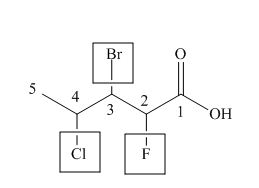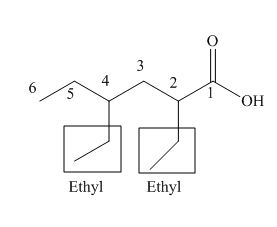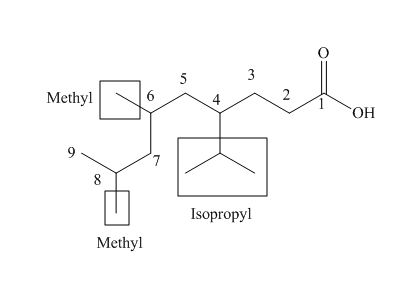
Give the IUPAC name for each compound.

(a)
Interpretation:
The IUPAC name for the given compound is to be stated.
Concept introduction:
The chemical structures are described by IUPAC name or common names. IUPAC nameis different from common names because IUPAC nameis applied at international level and it comprises suffix, prefix, numbers and other priority rules.
Answer to Problem 19.1P
The IUPAC name of the compound is
Explanation of Solution
The numbering of carbon atoms in the given compound is shown below.

Figure 1
The given compound has a chain of six carbon atoms. The carboxylic acid is present as a functional group in the compound. Two methyl groups are present at a third carbon atom. Therefore, the name of the compound is
The IUPAC name of the given compound is
(b)
Interpretation:
The IUPAC name for the given compound is to be stated.
Concept introduction:
The chemical structures are described by IUPAC name or common names. IUPAC name is different from common names because IUPAC name is applied at international level and it comprises suffix, prefix, numbers and other priority rules.
Answer to Problem 19.1P
The IUPAC name of the compound is
Explanation of Solution
The numbering of carbon atoms in the given compound is shown below.

Figure 2
The given compound has a chain of five carbon atoms. The carboxylic acid is present as a functional group in the compound. Fluorine, chlorine and bromine is present at second, third and fourth carbon atoms respectively. Therefore, the name of the compound is
The IUPAC name of the compound is
(c)
Interpretation:
The IUPAC name for the given compound is to be stated.
Concept introduction:
The chemical structures are described by IUPAC name or common names. IUPAC name is different from common names because IUPAC name is applied at international level and it comprises suffix, prefix, numbers and other priority rules.
Answer to Problem 19.1P
The IUPAC name of the compound is
Explanation of Solution
The numbering of carbon atoms in the given compound is shown below.

Figure 3
The given compound has a chain of six carbon atoms. The carboxylic acid is present as a functional group in the compound. Two ethyl groups are present at second and fourth carbon atoms. Therefore, the name of the compound is
The IUPAC name of the compound is
(d)
Interpretation:
The IUPAC name for the given compound is to be stated.
Concept introduction:
The chemical structures are described by IUPAC name or common names. IUPAC name is different from common names because IUPAC name is applied at international level and it comprises suffix, prefix, numbers and other priority rules.
Answer to Problem 19.1P
The IUPAC name of the compound is
Explanation of Solution
The numbering of carbon atoms in the given compound is shown below.

Figure 4
The given compound has a chain of nine carbon atoms. The carboxylic acid is present as a functional group in the compound. Two methyl groups are present at eighth and nine carbon atoms, while one isopropyl group is present at fourth carbon. Therefore, the name of the compound is
The IUPAC name of the compound is
Want to see more full solutions like this?
Chapter 19 Solutions
Organic Chemistry-Package(Custom)
- Indicate the products obtained by mixing 2,2-dimethylpropanal with acetaldehyde and sodium ethoxide in ethanol.arrow_forwardSynthesize 2-Ethyl-3-methyloxirane from dimethyl(propyl)sulfonium iodide using the necessary organic or inorganic reagents. Draw the structures of the compounds.arrow_forwardSynthesize 2-Hydroxy-2-phenylacetonitrile from phenylmethanol using the necessary organic or inorganic reagents. Draw the structures of the compounds.arrow_forward
- Synthesize N-Methylcyclohexylamine from cyclohexanol using the necessary organic or inorganic reagents. Draw the structures of the compounds.arrow_forwardSynthesize N-Methylcyclohexylamine from cyclohexanol using the necessary organic or inorganic reagents. Draw the structures of the compounds.arrow_forwardIf possible, please provide the formula of the compound 3,3-dimethylbut-2-enal.arrow_forward
- Synthesize 1,4-dibromobenzene from acetanilide (N-phenylacetamide) using the necessary organic or inorganic reagents. Draw the structures of the compounds.arrow_forwardIndicate the products obtained by mixing (3-oxo-3-phenylpropyl)triphenylphosphonium bromide with sodium hydride.arrow_forwardWe mix N-ethyl-2-hexanamine with excess methyl iodide and followed by heating with aqueous Ag2O. Indicate the major products obtained.arrow_forward
- Indicate the products obtained by mixing acetophenone with iodine and NaOH.arrow_forwardIndicate the products obtained by mixing 2-Propanone and ethyllithium and performing a subsequent acid hydrolysis.arrow_forwardIndicate the products obtained if (E)-2-butenal and 3-oxo-butanenitrile are mixed with sodium ethoxide in ethanol.arrow_forward
